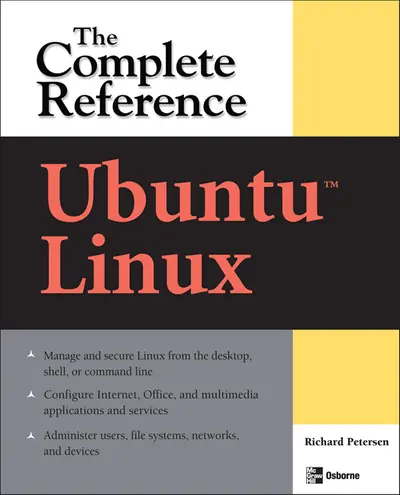My Account Details

ISBN10: 0071598464 | ISBN13: 9780071598460

Step 1 . Download Adobe Digital Editions to your PC or Mac desktop/laptop.
Step 2. Register and authorize your Adobe ID (optional). To access your eBook on multiple devices, first create an Adobe ID at account.adobe.com. Then, open Adobe Digital Editions, go to the Help menu, and select "Authorize Computer" to link your Adobe ID.
Step 3. Open Your eBook. Use Adobe Digital Editions to open the file. If the eBook doesn’t open, contact customer service for assistance.
Publisher's Note: Products purchased from Third Party sellers are not guaranteed by the publisher for quality, authenticity, or access to any online entitlements included with the product. The Definitive Guide to Ubuntu--Covers Ubuntu 8.04 LTS Maximize the powerful features of Ubuntu with expert guidance, tips, and techniques from bestselling Linux author Richard Petersen. Packed with clear explanations and detailed examples, this comprehensive volume shows you how to get off the ground with Ubuntu, set up hardware and Internet connections, and use the latest system and network administration utilities. Ubuntu: The Complete Reference covers the desktops, shells, and administration tools for users, printers, services, and networks. Get full details on the latest Ubuntu-compatible office, mail, Web, and multimedia software, along with remote access (Vinagre), virtualization (KVM and Xen) and service managment (Upstart).You'll also learn how to interoperate with Windows networks and deploy reliable security using PolicyKit, Seahorse, AppArmor, SELinux, netfilter, and the Secure Shell. Install Ubuntu using Live CDs, the Install DVD, or Wubi Windows virtual disk Configure printers, devices, and network connections Access Linux using GNOME, KDE, KDE4, and XFce desktops Manage software with Synaptic Package Manager and APT Work with the BASH shell command, configuration, and file management capabilities Use office, Web (Firefox 3), mail, and multimedia applications (PulseAudio) Manage file systems including RAID and LVM Secure Ubuntu using PolicyKit authentication, Seahorse encryption, SSH and Kerberos security, AppArmor access controls, and Firestarter and UFW firewalls Use SAMBA and NFS to share network resources
Chapter 1 - Introduction to Ubuntu
Chapter 2 - Installing Ubuntu
Chapter 3 - Interface Basics: Login, Desktop, and Help
Part II - Configuration
Chapter 4 - Administration Tasks
Chapter 5 - Network Connections
Chapter 6 - Software Installation
Chapter 7 - Software Management with DEB, APT, and dkpg
Part III - Desktops
Chapter 8 - GNOME
Chapter 9 - KDE, KDE-4, and Xfce
Part IV - Using the Shell
Chapter 10 - The Shell
Chapter 11 - Shell Configuration
Chapter 12 - Files, Directories, and Archives
Part V - Applications
Chapter 13 - Office and Database Applications
Chapter 14 - Graphics Tools and Multimedia
Chapter 15 - Mail and News Clients
Chapter 16 - Web Browsers, FTP, Java, VoIP, and IM
Part VI - Security
Chapter 17 - Authorization, Encryption, and Permissions
Chapter 18 - AppArmor and Security-Enhanced Linux
Chapter 19 - Secure Shell and Kerberos
Chapter 20 - Firewalls
Part VII - System Administration
Chapter 21 - Basic System Administration
Chapter 22 - Managing Users
Chapter 23 - File Systems
Chapter 24 - RAID and LVM
Chapter 25 - Devices and Modules
Chapter 26 - Kernel Administration
Chapter 27 - Backup Management
Part VIII - Local Services
Chapter 28 - Managing Services
Chapter 29 - Print, News, and Database Services
Chapter 30 - Shared Resources: Samba and NFS
Appendix A - Obtaining the Distribution
Index
Need support? We're here to help - Get real-world support and resources every step of the way.